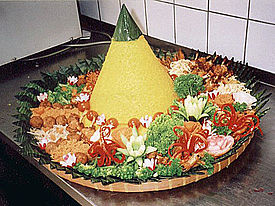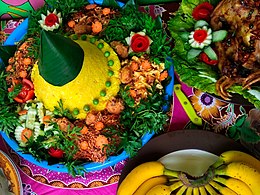
Back টুম্পেং Assamese Tumpeng Spanish Tumpeng French Tumpeng ID Tumpeng Italian Tumpeng JV 툼픙 Korean Sega tumpeng MAP-BMS തുംപെങ് Malayalam Tumpeng Malay
 Tumpeng: the cone-shaped rice surrounded by assorted Indonesian dishes. | |
| Course | Main course |
|---|---|
| Place of origin | Indonesia[1] |
| Region or state | Java, Nationwide |
| Associated cuisine | Indonesia |
| Serving temperature | Hot or room temperature |
| Main ingredients | Cone-shaped rice, urab (vegetables in shredded coconut), fried chicken, fried tempeh, boiled marble egg, shredded omelette, salted anchovy and peanuts |
| Variations | Tumpeng robyong, tumpeng putih, tumpeng nasi uduk, tumpeng slametan (nasi kuning) |
 |
| This article is part of the series on |
| Indonesian cuisine Masakan Indonesia |
|---|
|
|
Tumpeng (Javanese: ꦠꦸꦩ꧀ꦥꦼꦁ; Balinese: ᬢᬸᬫ᭄ᬧᭂᬂ) is an Indonesian cone-shaped rice dish with side dishes of vegetables and meat originating from Javanese cuisine of Indonesia. Traditionally featured in the slamatan ceremony, the rice is made by using a cone-shaped woven bamboo container. The rice itself may be plain steamed rice, uduk rice (cooked with coconut milk), or yellow rice (uduk rice colored with kunyit (turmeric)).[1]
The rice cone is set out on the tampah (rounded woven bamboo container), preliminary covered with a banana leaf, and surrounded by assorted Indonesian dishes. In 2013, the Indonesian Ministry of Tourism and Creative Economy promoted tumpeng as one of 30 Indonesian culinary icons[2] and declared it Indonesia's official national dish in 2014, describing it as "the dish that binds the diversity of Indonesian various culinary traditions."[3]
Tumpeng is a symbol of gratitude.[1] According to folklore in Java and Bali, the cone-shaped tumpeng is a symbol of life and of the glory of God as the creator of nature, and the side dishes and vegetables represent the life and harmony of nature. Usually tumpeng is served with spinach, which is a traditional symbol of prosperity in Javanese agricultural society.[4]
- ^ a b c Riyan (8 April 2013). "The Rice Cone or "Nasi Tumpeng", Traditional Rice Cone, the Pride of Indonesia". Describe Indonesia. Retrieved 11 June 2014.
- ^ "Tumpeng, Ikon Kuliner Indonesia" (in Indonesian). Travel Kompas.com. 22 April 2013. Retrieved 11 June 2014.
- ^ Nadya Natahadibrata (10 February 2014). "Celebratory rice cone dish to represent the archipelago". The Jakarta Post. Retrieved 2014-07-09.
- ^ Folklore, Javanese. "What Tumpeng Means for us Indonesian". www.indonesiapa.com. Indonesiapa Webzine. Archived from the original on 14 July 2014. Retrieved 12 July 2014.